COMM
5.0(2)
Card Sorting
1/129
There's no tags or description
Looks like no tags are added yet.
Study Analytics
Name | Mastery | Learn | Test | Matching | Spaced |
|---|
No study sessions yet.
130 Terms
1
New cards
2\.0 LOCAL AND GLOBAL COMMUNICATION
2
New cards
set of shared attitudes, values, goals, and practices that characterizes institution or organization
Culture
3
New cards
the complex whole which includes knowledge, belief, art, morals, law, customs and habits, and any capabilities acquired by man as a member of society
Culture
4
New cards
customary beliefs, social forms and material traits of a racial, religious or social group
Culture
5
New cards
relating to or constituting several cultural or ethnic groups within a society
Multicultural
6
New cards
people with different nationalities, languages, religions and ethnicities live together.
Multicultural Society
7
New cards
view that cultures, races, and ethnicities, particularly those of minority groups,
Multiculturalism
8
New cards
inclusion of the views and contributions of diverse members of society
Multiculturalism
9
New cards
it is how people belonging to different cultures communicate with each other.
Cross Cultural Communication
10
New cards
refers to the attempts that are made to exchange, negotiate and mediate cultural differences by means of language, gestures and body language
Cross Cultural Communication
11
New cards
Importance of Cross Cultural Communication
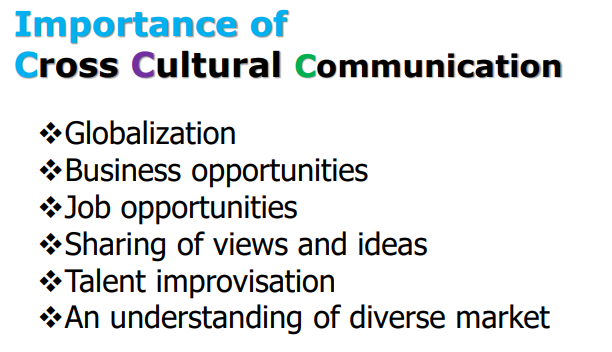
12
New cards
is being able to communicate (verbal and non-verbally) with the members of your local area/community
Local Communication
13
New cards
a group of interacting people sharing an environment.
Local Community
14
New cards
communicating with people across the globe;
Global Communication
15
New cards
exchanging of knowledge, ideas, and information and interaction of individual across the borders instead of a limited or local area.
Global Communication
16
New cards
Global Communication Example
* Government-to-government
* Business-to-business
* People-to-people
\
* Business-to-business
* People-to-people
\
17
New cards
Communication between two or more governments related to different countries. Maybe a discussion about current affairs and conflicts
Government-to-government
18
New cards
Involves interaction between two or more international business parties. Maybe any deal contract
Business-to-business
19
New cards
Refers to communication between two or more people living far away across the borders. Like talk of two best friends. One in USA and other in the UK.
People-to-people
20
New cards
Difference of Local and Global Communication in terms of Degree in Equality

21
New cards
Difference of Local and Global Communication in terms of Context
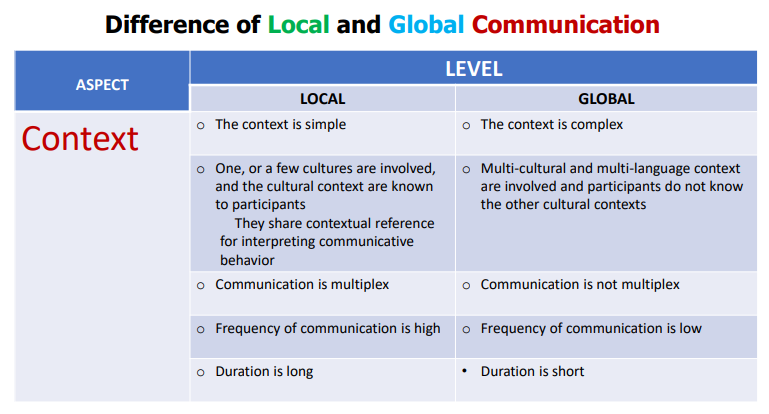
22
New cards
It is essential in any workplace.
Communication
23
New cards
It is a very important component of the communication process,
Language
24
New cards
How to communicate effectively with a culturally diverse persons
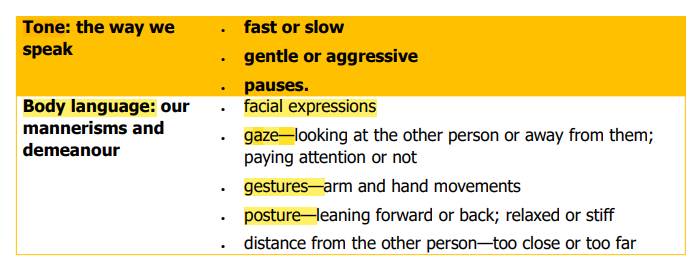
25
New cards
3 elements of face to face communication (percent)
* **Tone - 30%**
* Verbal - 10%
* Body Language - 60%
* Verbal - 10%
* Body Language - 60%
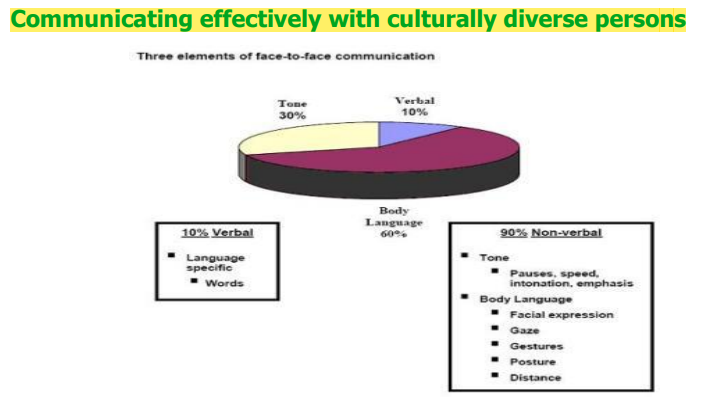
26
New cards
being aware that cultural differences and similarities between people exist without assigning them a value- positive or negative, better or worse, right or wrong.
Cultural Sensitivity
27
New cards
It implies that both groups understand and respect each other’s characteristics.
Cultural sensitivity
28
New cards
2 Stages of Intercultural Sensitivity
* Ethnocentric stage
* Ethnorelative stage
* Ethnorelative stage
29
New cards
Enumerate the stage in Ethnocentric stage

30
New cards
* people don’t recognize cultural differences and experiences
* they believe their culture is the only “real” one and they tend to interact in homogenous groups and to stereotype everyone else
* they believe their culture is the only “real” one and they tend to interact in homogenous groups and to stereotype everyone else
Denial
31
New cards
* people don’t recognize some differences
* assume their culture is the most evolved, the best one.
* assume their culture is the most evolved, the best one.
Defense
32
New cards
* unaware that they are projecting their own cultural values.
* They see their own values as superior.
* They see their own values as superior.
Minimization
33
New cards
Enumerate the stage in Ethnorelative stage

34
New cards
able to shift perspectives to understand that the same “ordinary” behavior can have different meanings in different cultures.
Acceptance
35
New cards
Individuals become more competent in their ability to communicate with other cultures.
Adaptation
36
New cards
* able to shift easily from one cultural frame of reference to another.
* develop empathy for other cultures.
\
* develop empathy for other cultures.
\
Integration
37
New cards
2\.1 COMMUNICATION AND GLOBALIZATION
38
New cards
When was Ferdinand Marcos Martial law?
Sept. 23, 1972
39
New cards
When was the start of EDSA People Power Revolution
Feb. 25, 1986
40
New cards
who played a key role in calling on people over Radio Veritas to go to EDSA?
Manila Archbishop Jaime Cardinal
41
New cards
this radio station was captured by gov’t troops but continued broadcasting vital information over Radyo Bandido at a secret location
Radio Veritas
42
New cards
these 2 medium of communication played crucial role in reporting current events and sharing significant information.
* Traditional media as broadcast (TV and radio)
* print (newspaper and magazines)
* print (newspaper and magazines)
43
New cards
what is the title of the song that was performed by well-known Filipino singers on TV and radio. It captured the triumphant feeling of a people toppling a dictatorship without bloodshed in music
“Handog ng Pilipino sa Mundo”
44
New cards
popular term that describes how and why the world continues to evolve in the ways that it does.
Globalization
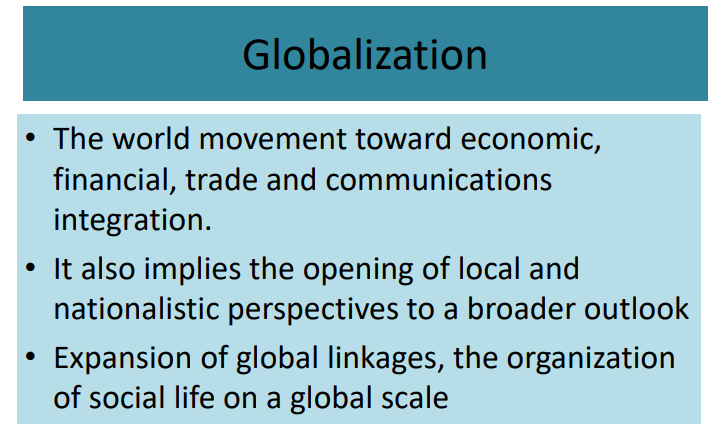
45
New cards
Examples of Globalization
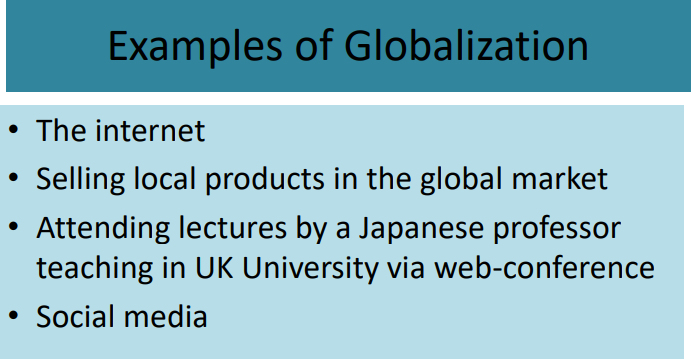
46
New cards
What is the slogan of environmental advocates (late 1980s)
“think globally, act locally”
47
New cards
How Cultural and Global Issues Affect Communication?
1. Increased business opportunities
2. Fewer Cultural Barriers
3. Creation of a Global Village
48
New cards
a term coined by theorist Marshall McLuhan to describe the impact of communication and transportation technologies which reduce the distance between parts of the world
Global village
49
New cards
Example of a Global Village
* online courses, distance learning
* Virtual assistant jobs
* ▪Globalization and global communication
* Virtual assistant jobs
* ▪Globalization and global communication
50
New cards
How has globalization affected how people communicate?

51
New cards
3\.1 COMMUNICATING IN A MULTICULTURAL SOCIETY AND WOLRD
52
New cards
increasing economic, political, and cultural integration and interdependence of diverse cultures- the world wide integration of humanity
Globalization
53
New cards
the recognition and valuing of the difference, encompassing such factors as age, gender, race, ethnicity, ability, religion, education, marital status, sexual orientation and income
Diversity
54
New cards
* a theorist who predicted many years ago that our world would become a global village
* At this era, people are linked _ and _ around the glob
* At this era, people are linked _ and _ around the glob
* Marshall McLuhan
* physically and electronically
* physically and electronically
55
New cards
helped erased the notion of territorial boundaries between countries, gradually eroding the idea of the term nation
Digital technology
56
New cards
persons respectful of and engaged with people from distinctly different cultures.
Multiculturalists
57
New cards
____ can be judged as insensitive, ignorant or culturally confused when they fail to realize the people from different cultures and whom they interact with.
Communicators
58
New cards
\- lacking understanding of cultural difference
Culturally confused
59
New cards
___ affects communication
Cultural ignorance
60
New cards
interaction with individuals from different cultures
Intercultural communication
61
New cards
Forms of Intercultural Communication

62
New cards
composed of members of the same general culture who differ in some ethnic or sociological way from the parent culture
Co-cultures
63
New cards
group whose members feel like outsiders
Marginalized group
64
New cards
being perceived as the majority of the population and having a significant presence in institutions relating to communication, education, artistic expression, law, government and business
Dominant cultures
65
New cards
Strategies of co-culture members to join in the dominant culture
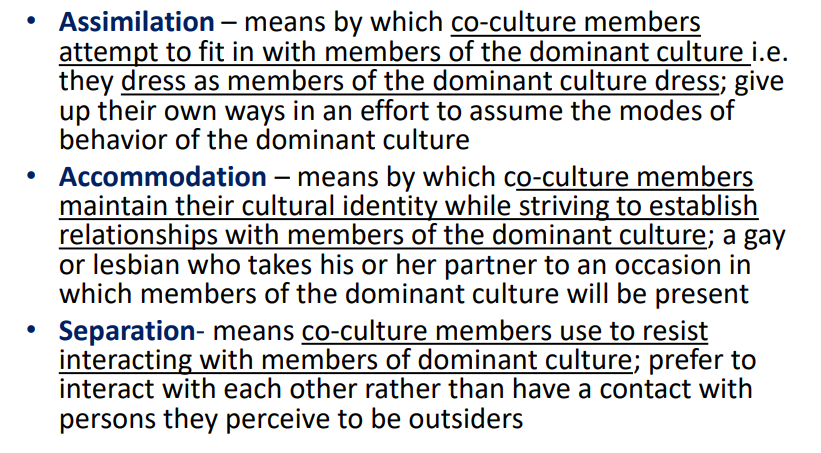
66
New cards
Preferred strategies and communication approaches of marginalized groups
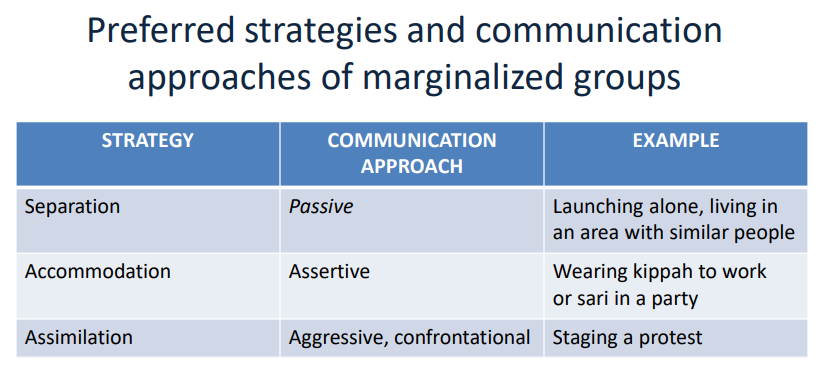
67
New cards
the lens through which we see the world
Culture
68
New cards
tendency to see one’s own culture as superior to all
Ethnocentrism
69
New cards
the acceptance of other cultural groups as equal in value to one’s own
Cultural relativism
70
New cards
the view that different cultures should be assimilated into the dominant culture
Melting-pot philosophy
71
New cards
adherence to the principle of cultural relativism
Cultural pluralism
72
New cards
Individualism versus Collectivism
\
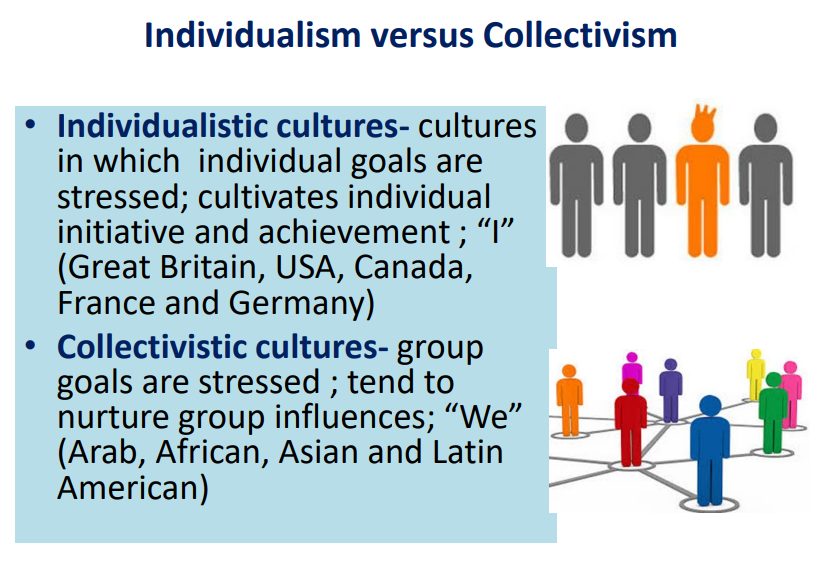
73
New cards
High context versus Low context
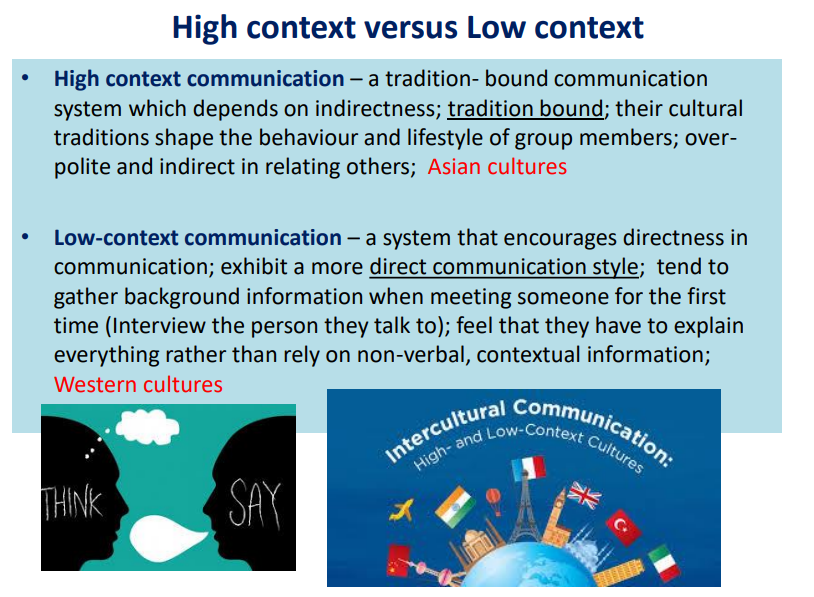
74
New cards
High power distance versus low power distance cultures
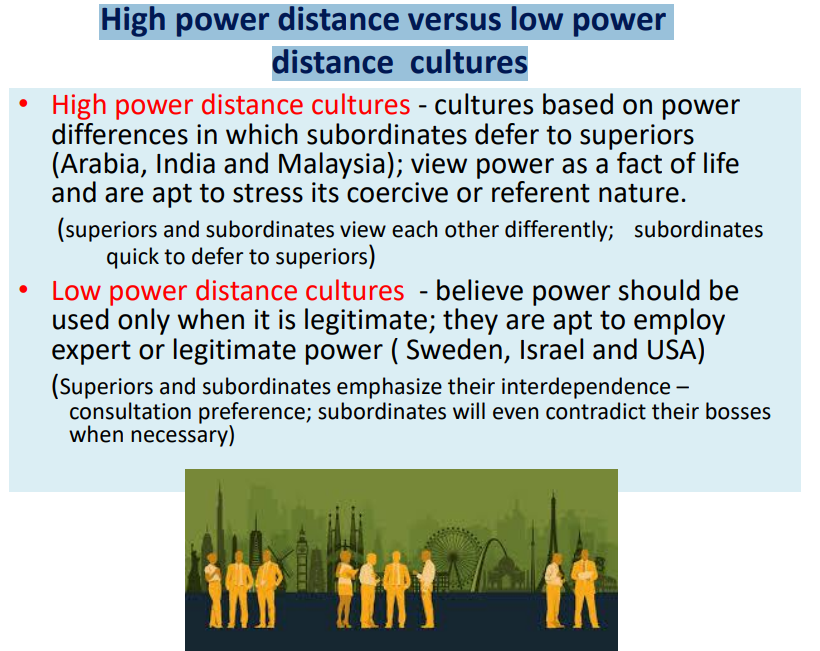
75
New cards
Masculine versus feminine cultures
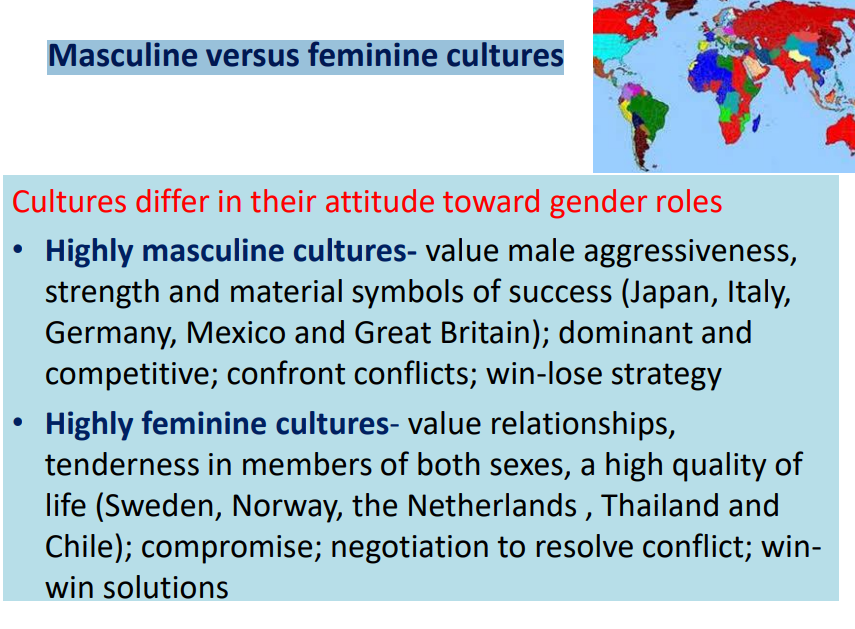
76
New cards
refers to the way of presenting themselves
Gender roles-
77
New cards
socially constructed; share experience of oppression
Racial and Ethnic identity-
78
New cards
has to do with belief on faith issues
Religious identity-
79
New cards
related to the widening gap between the ultrawealthy, and middle and lower classes
Socioeconomic identity-
80
New cards
refers to the legal status or citizenship
National identity-
81
New cards
mental images or pictures that we believe on; shortcuts (poisitive or negative) that guide reactions
• Stereotypes-
82
New cards
a positive or negative prejudgement; leads to the creation of in-groups and out-groups, with out-group members becoming easy for discrimination
Prejudice-
83
New cards
3\.2 - APPRECIATING IMPACT OF COMMUNICATION ON SOCIETY AND THE WORLD
84
New cards
Today’s manner of communication is characterized by
* the constancy of connectivity
* convergence
* interactivity
* convergence
* interactivity
85
New cards
is achieved when communication is made possible through technology overlaps face-to-face communication
Convergence
86
New cards
it grants online participation anytime and anywhere
Interactivity
87
New cards
DIFFERENCE BETWEEN FIRST MEDIA AGE AND SECOND MEDIA AGE

88
New cards
a group of Internet-based applications that build on the ideological and technological foundations of Web 2.0, and that allow the creation and exchange of usergenerated content” (Kaplan and Haenlein, 2010 as cited by Suarez, et.al)
Social media
89
New cards
CLASSIFICATION OF SOCIAL MEDIA
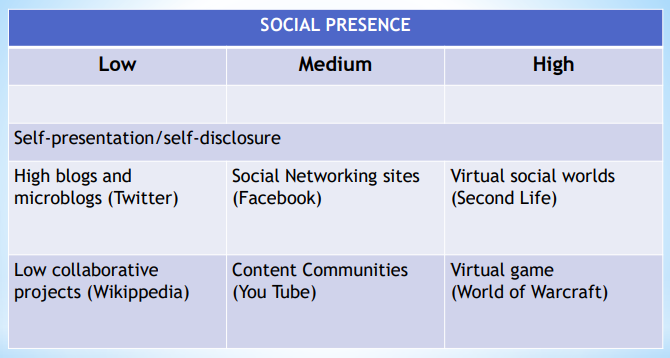
90
New cards
EXAMPLE OF SOCIAL MEDIA PLATFORMS
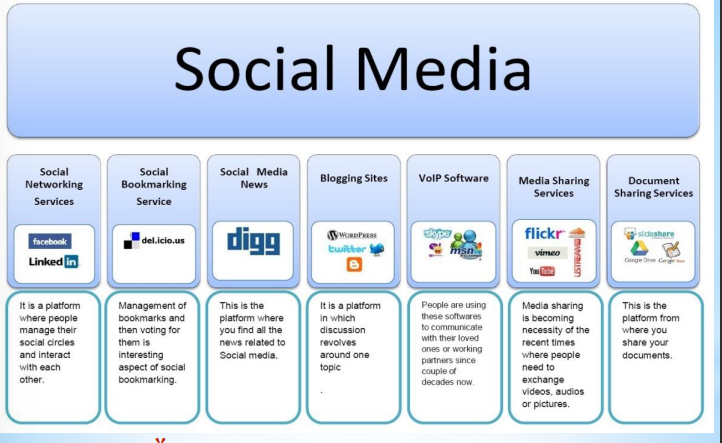
91
New cards
an image or video that represents the thoughts and feelings of a specific audience. Most memes are captioned photos intended to elicit humor.
Meme
92
New cards
A __is a virally-transmitted photograph that is embellished with text that pokes fun at a cultural symbol or social idea.
meme
93
New cards
What are the feature of meme?
1. Intertextuality
2. Indexicality
3. Templatability
94
New cards
interconnections between similar or related works perceived by an audience or reader of the text.
Intertextuality
95
New cards
an element in one meme can be used to comment on many situations.
Indexicality
96
New cards
Memes have recognisable structures with spaces for new content
Templatability
97
New cards
\*Internet is “___”
networked public
98
New cards
4 Features of Internet
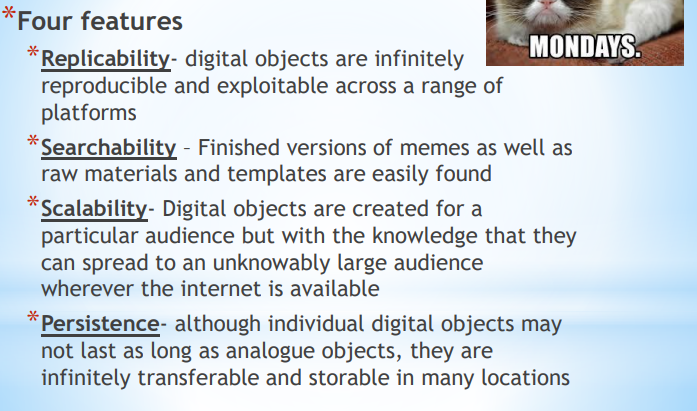
99
New cards
4 - EVALUATING MESSAGES AND IMAGES
100
New cards
having or involving several modes, modalities
Multimodal